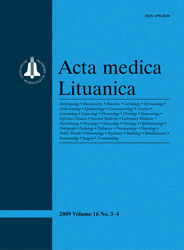 ISSN 1392-0138 ISSN 2029-4174 (online) |
2010 m. Nr. 1-2 How should a clinician interpret results of randomized
controlled trials?
Randomized controlled trials (RCTs) and systematic reviews are the most reliable methods of determining the effects of treatment. The randomization procedure gives a randomized controlled trial its strength. Random allocation means that all participants have the same chance of being assigned to each of the study groups. The choice of which end point(s) to select is critical to any study design. Intention-to-treat is the preferred approach to the analysis of clinical trials. Sample size calculations and data analyses have an important impact on the planning, interpretation, and conclusions of randomized trials. In this article, we discuss the problematic areas that can affect the outcome of a trial, such as blinding, sample size calculation, randomization; concealment allocation; intention of treating the analysis; selection of end points; selection of traditional versus equivalence testing, early stopped trials, selective publications. Keywords: randomized controlled trials, sample size, outcomes, type of analyses |
Issues:
2011 - Vol.18 No. 1, No. 2, No. 3, No. 4 2010 - Vol.17 No. 1-2, No. 3-4 2009 - Vol.16 No. 1-2, No. 3-4 2008 - Vol.15 No. 1, No. 2, No. 3, No. 4 2007 - Vol.14 No. 1, No. 2, No. 3, No. 4 2006 - Vol.13 No. 1, No. 2, No. 3, No. 4 2005 - Vol.12 No. 1, No. 2, No. 3, No. 4 2004 - Vol.11 No. 1, No. 2, No. 3, No. 4 2003 - Vol.10 No. 1, No. 2, No. 3, No. 4 2002 - Vol.9 No. 1, No. 2, No. 3, No. 4 2001 - Vol.8 No. 1, No. 2, No. 3, No. 4 |